Meet the Tai Shu Maru
The Tai Shu Maru is a tsunami boat.
It was one of thousands of boats that was pulled into the ocean on March 11, 2011 by the Great East Japan tsunami. This drifted in the ocean for more than three years before beaching on the Humboldt County Coast in Northern California.
This web page introduces you to the Tai Shu Maru, Japanese for Big Win Boat. This small fiberglass boat was discovered by a group of kayakers in June, 2014, more than 38 months after the tsunami. You can visit the National Weather Service Office on Woodley Island in Eureka, California to see this boat and learn more about how we know it was from the tsunami, how it traveled across the ocean and the lessons this boat can teach all of us about resilience.
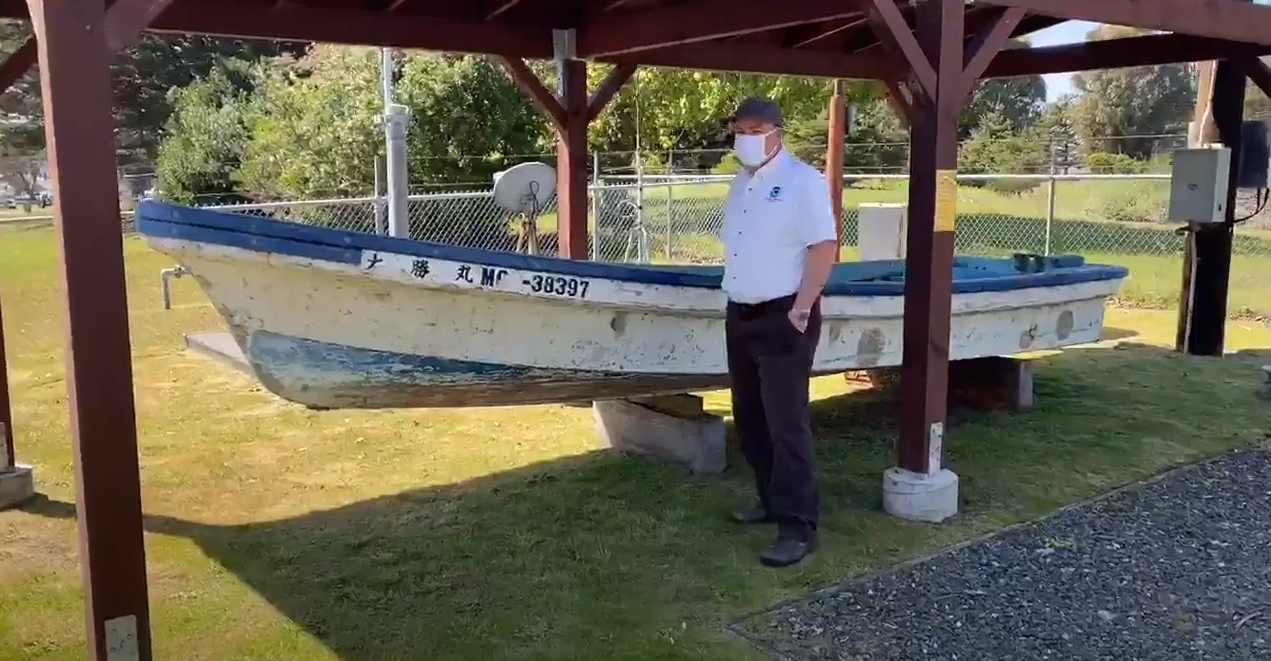
Troy Nicolini (Meteorologist in Charge, NWS Eureka, CA) presents the Tai Shu Maru stored on Woodley Island. Photo provided by Lori Dengler.
On March 11, 2011, the Tai Shu Maru was tied up on a platform in a small fishing harbor in Japan’s Miyagi Prefecture. We know this because the boat had a registration number on the side and the Japanese Consulate in San Francisco was able to trace it back to where it had been stored. Before the tsunami, it was a hard working fishing boat.
At 2:46 PM local time in Japan, a magnitude 9.1 earthquake shook the harbor area and all of Northern Japan. About an hour after the earthquake, a series of tsunami surges swept into the harbor, pulling boats, buildings and other debris into the ocean. The Japanese government estimated that the tsunami pulled more than five million tons of material – homes, office buildings, warehouses, vehicles, and boats of all sizes – into the ocean. Most of this debris sank close to the coast or was washed back onto the shore.
About a third of the debris, including the Tai Shu Maru, was pulled far enough offshore by the tsunami to be caught in the North Pacific Gyre, the great rotating current in the northern Pacific. There are five great gyres in the world’s oceans driven by the temperature change from equator to poles and the earth’s rotation. The North Pacific Gyre includes most of the northern Pacific, moving to the northeast offshore of Japan’s Pacific coast, then east towards the west coast of North America, paralleling the US West Coast to south of Baja, and then heading west back to Japan.
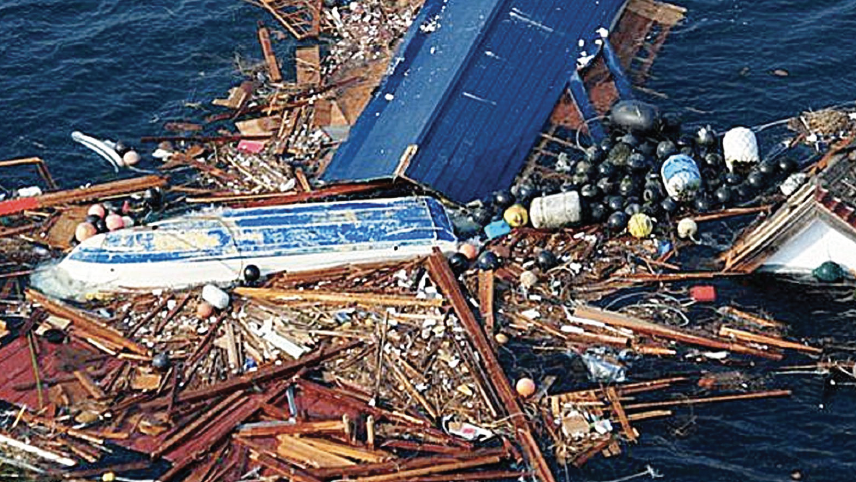
This photo provides an example of the tsunami debris produced by the 2011 tsunami. Photo from Ho New/Reuters/REUTERS.
Sealife settled on the Tai Shu Maru as it drifted
The Tai Shu Maru was probably flipped upside down early on in its voyage, perhaps by the tsunami or by strong storm waves soon after. The shape of the boat makes it very stable when upside down, floating low in the water with only the very bottom of the hull above water. We know this because only the bottom of the boat was barnacle-free. It was pulled by the tsunami many miles off the coast where it was caught in the gyre.
The Tai Shu Maru probably did not move on a steady course. Eddies in the gyre moved it in a more complex pattern and great storm systems could have sent the boat backwards for a while or in circles. On average, the boat moved at about the speed of a slow jogger to the east. This animation by the International Pacific Research Center in one possible way the debris may have moved.
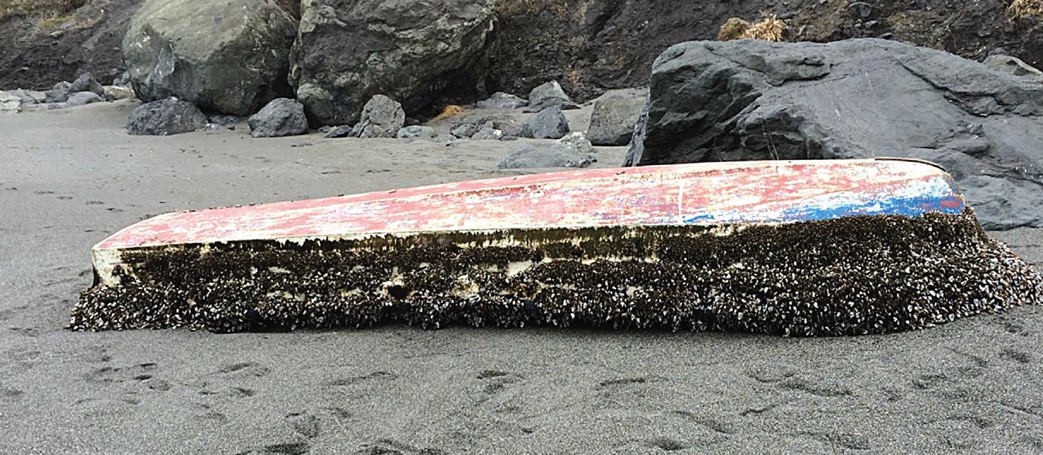
Photo of the Tai Shu Maru as it was found in Dry Lagoon. Photo by Lincoln Doyle.
The Tai Shu Maru was kept very clean when not at work. The boat was carefully washed and stored on dry land when not in use and rolled on poles into and out of the water. Once floating in the deep water, barnacle larvae and other organisms adhered to the sides of the boat, cementing themselves permanently to all of the surfaces underwater. Lepas anatifera, the common pelagic gooseneck barnacle, was the most common hitchhiker on the Tai Shu Maru. These barnacles grow long flexible stalks or necks. By the time the Tai Shu Maru beached, some of the stalks were over 18 inches long.
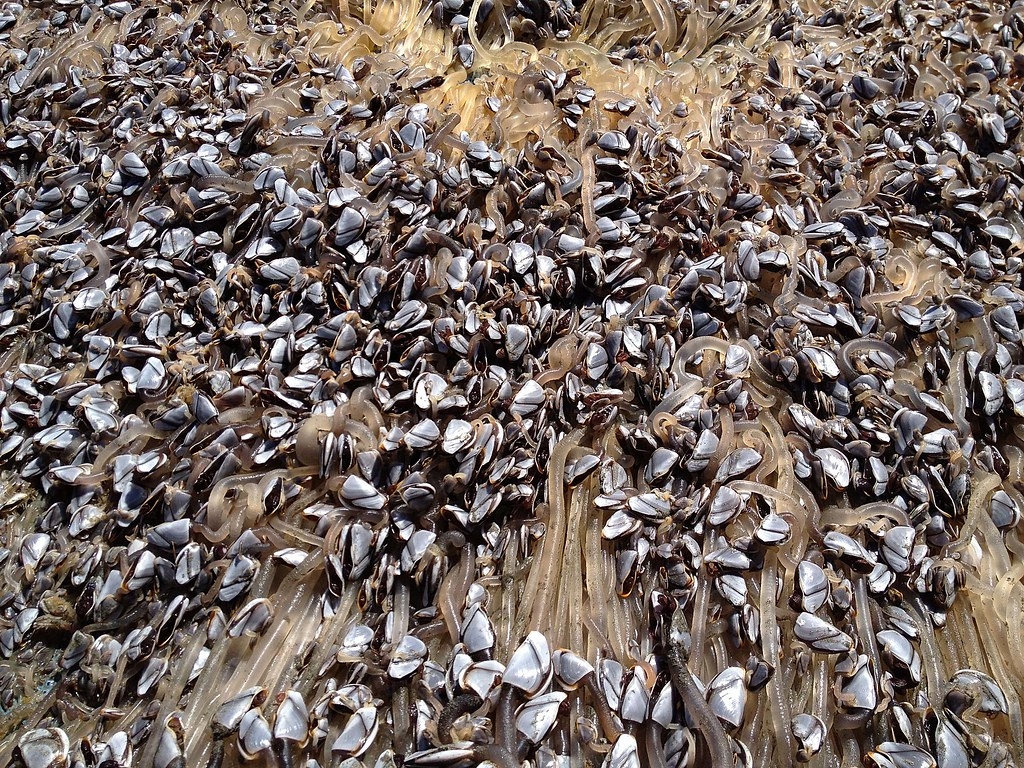
This shows pelagic gooseneck barnacles on another tsunami boat, Kamome that was found in 2013 in Del Norte County, California. Photo by Lori Dengler.
On June 1, 2014, a group of kayakers spotted something odd on the Dry Lagoon beach. They landed, took photographs and alerted the National Weather Service. A few days later, a group retrieved the boat and stored it at the Weather Service Office on Woodley Island. The boat’s registration number was sent to the Japanese Consulate in San Francisco. After several weeks, the boat was confirmed as being lost in the tsunami and no one wanted it to be returned.

The Tai Shu Maru spent three years in the Pacific Ocean!
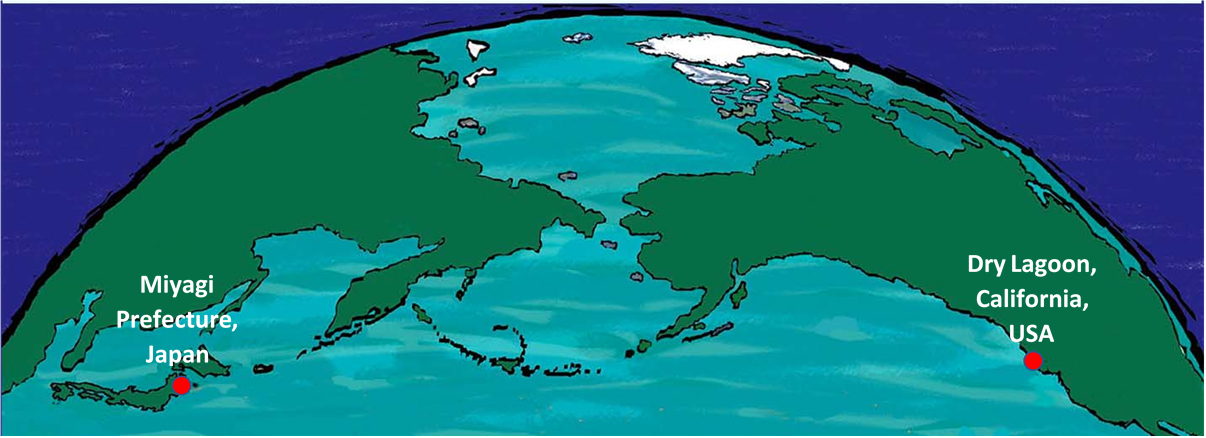
Since it was found, the Tai Shu Maru has been used to educate the North Coast community about tsunamis and marine debris. It was on display at the Humboldt County Fair in 2014 and 2015 and has been on display at the National Weather Service Office since then.
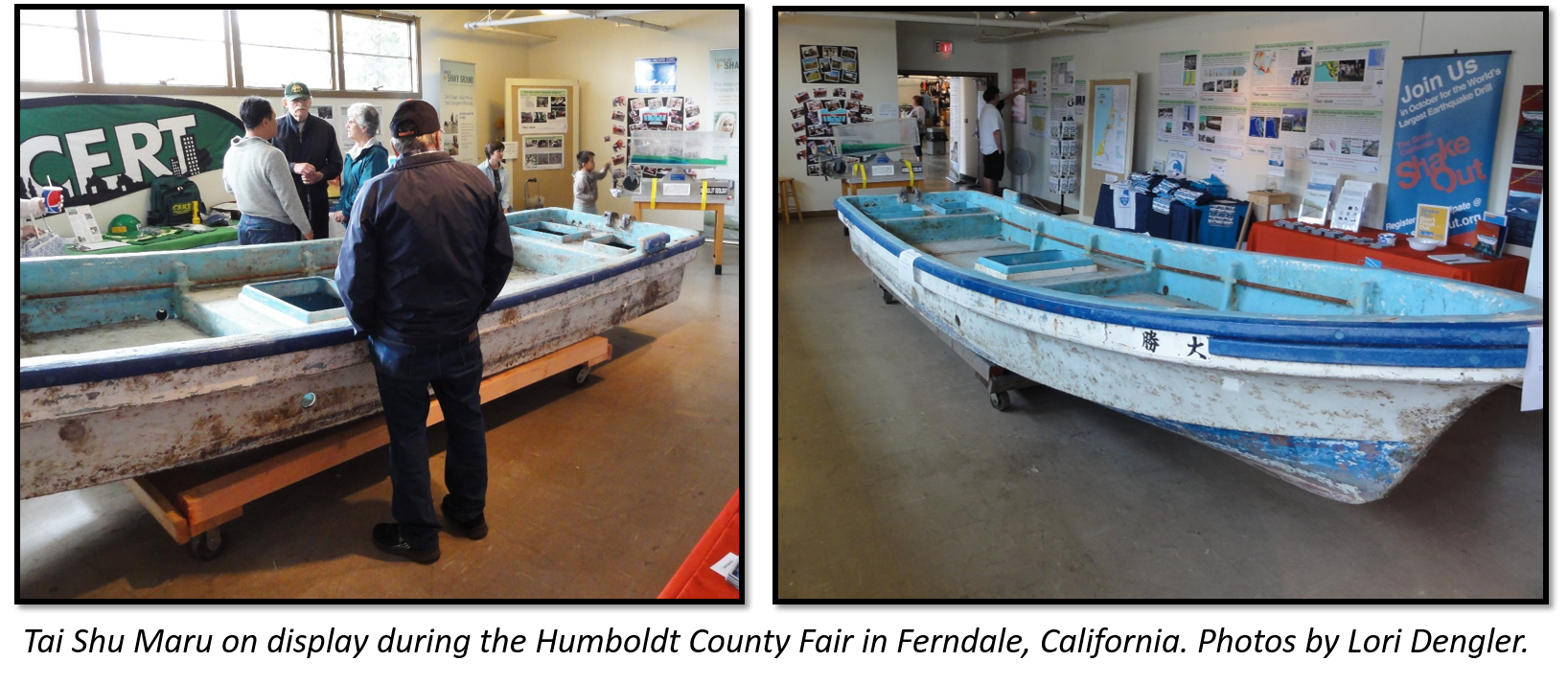
Explore the Tai Shu Maru!
Take a look at these features and learn about their significance.
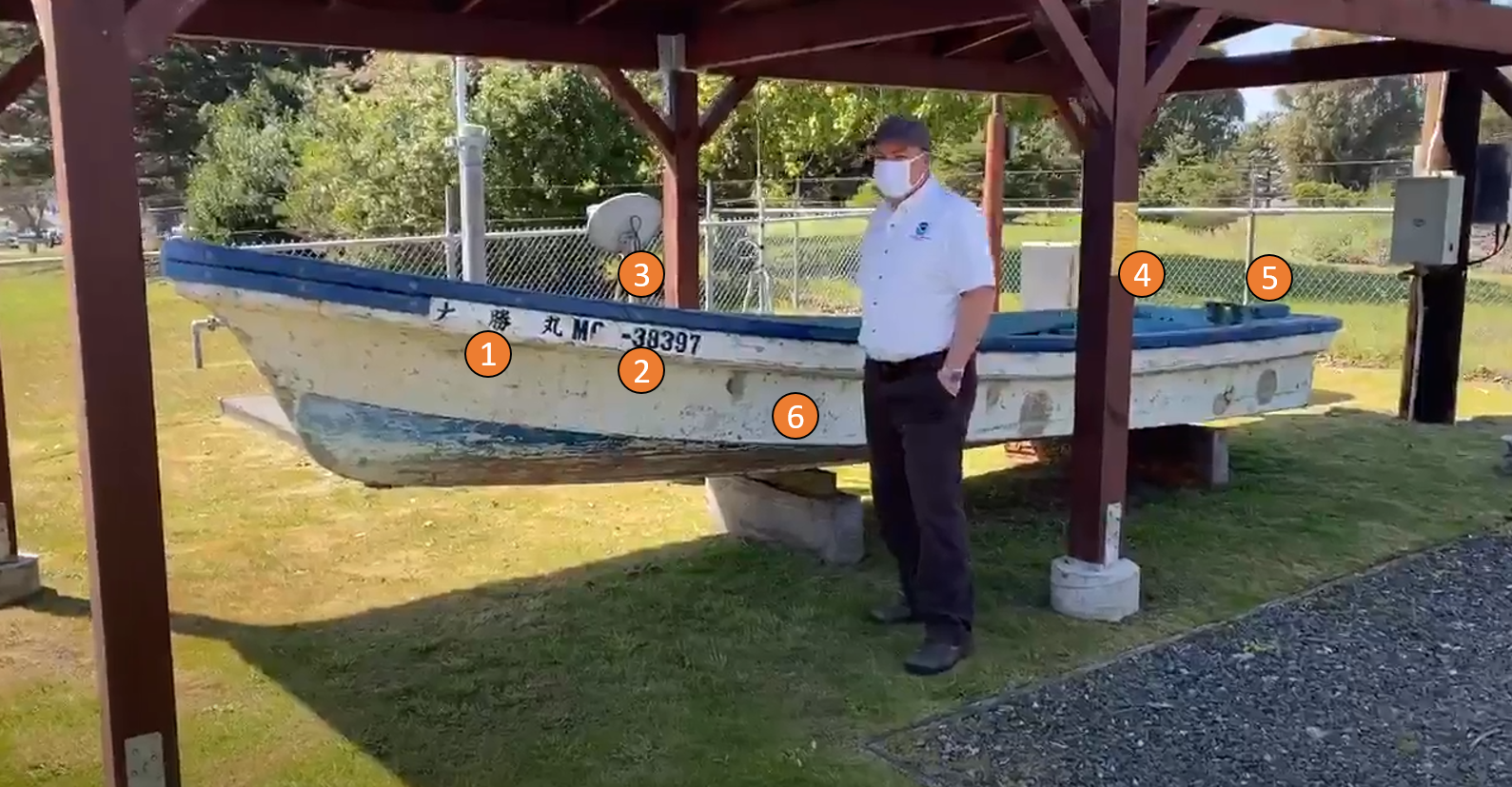

The name – the characters say Tai (big) Shu (win) Maru (boat)


The registration – MG3 – 38397 is the boat’s registration number. It is the number the Japanese authorities used to trace it back to Japan. MG stands for Miyagi Prefecture and the 3 means this boat was stored on land when not in use.
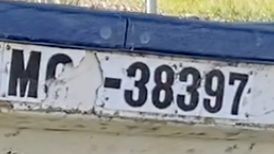

Scuff marks from the ropes - Note the grooves made on the hull from the hauling of lines over the side as the owner was fishing.
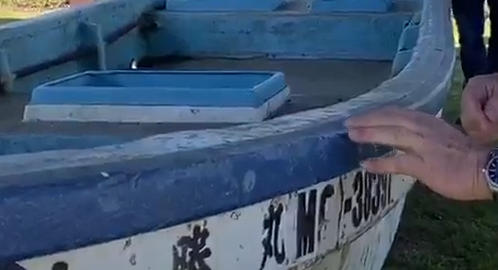

Broken rope - This boat was not being used at the time of the tsunami. It was tied to a rail at the back of the boat. The extreme force of the tsunami caused the rope to snap.
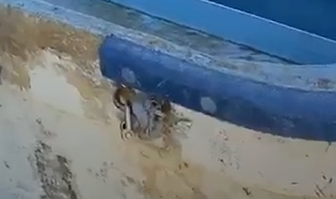

Broken engine mount - When the tsunami occurred, an outboard engine was still attached to the boat. The engine was broken off and only the mount remains.
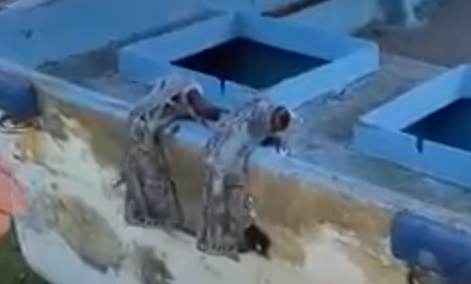

Marks where barnacles were attached- Notice the many small spots on the sides of the boat. These are the marks made where the barnacles were attached. Very small gooseneck barnacle larvae attached themselves to surfaces of the boat as it floated across the Pacific Ocean. By the time the boat beached three years later, some of the necks had grown to a foot and longer.
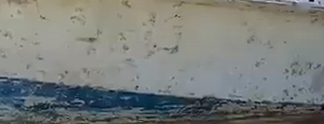
To learn more, watch our virtual tour of the Tai Shu Maru guided by Troy Nicolini from the National Weather Service Office in Eureka, California. You can also hear about Lori Dengler's connection to the Tai Shu Maru in her video below.
Let's Learn About Panga Boats
The Tai Shu Maru is a “panga boat”. Panga boats have a distinctive shape with a rounded, jutting-out prow, and open deck. They are stable even in rough seas and can be handled by a single person. They are the workhorses of central and south America, Japan, Philippines and Southeast Asia but uncommon in North America. When not used, they are typically stored onto a concrete deck like these new boats in Iwate Prefecture.
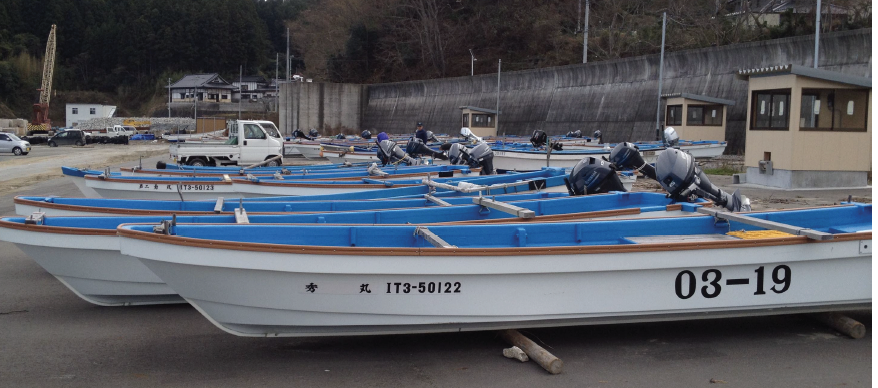
Panga boats are stored on paved platforms atop poles so they can be easily rolled into the water. Photo Lori Dengler.
Some panga boats are used to train students interested in working in harbors and in the fishing industry. A very special training boat, Kamome, landed on California’s north coast in 2013 near the town of Crescent City about 40 miles north of Dry Lagoon where the Tai Shu Maru came ashore. Kamome began a relationship between highschool students in Crescent City and Rikuzentakata, Japan when Del Norte High students worked to raise money and return Kamome to Japan. This began student exchanges, a Sister School and a Sister City relationship between Crescent City and Rikuzentakata. Learn more about the Extraordinary Voyage of Kamome at https://kamome.humboldt.edu/
Other Notable Tsunami Debris Stories
The Tai Shu Maru was only one of more than a hundred verified reports of tsunami debris carried from Japan to other areas of the Pacific after the 2011 tsunami. Thousands of other reports of possible Japan tsunami debris were also filed.
Learn more about these pieces of tsunami debris in Lori Dengler's Not My Fault Article Amazing tsunami voyages
Among the more notable reports were:
Ryou-Un Maru
Origin: fishing trawler Aomori Prefecture
Found: spotted 170 miles off the coast of Haida Gwaii, British Columbia 3/23/2012
Destroyed by the US Coast Guard on 4/5/2012 after attempts to salvage failed and it had drifted into US territorial waters.
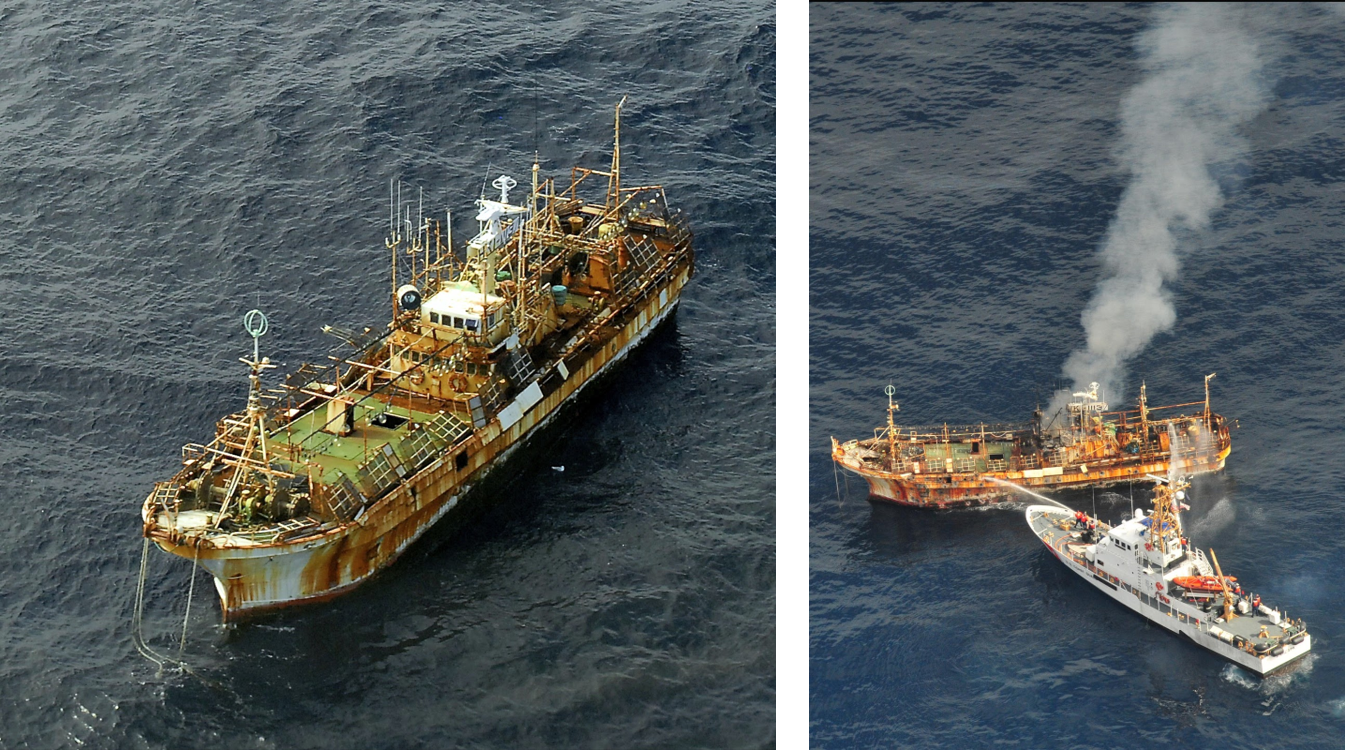
On the left, the Ryou-Un Maru was adrift offshore of SE Alaska on April 4, 2012. The photo on the right was from April 5, 2012 when the Ryou-Un Maru was being shelled by the US Coast Guard Vessel Anacapa.
Soccer Ball
Origin: Rikuzentakata, Iwate Prefecture
Found: April 19, 2012 on Middleton Island, Alaska.
Returned to owner
The soccer ball had been a farewell gift in 2005 to a third-grade student. The writing includes messages from classmates that helped to identify its owner.
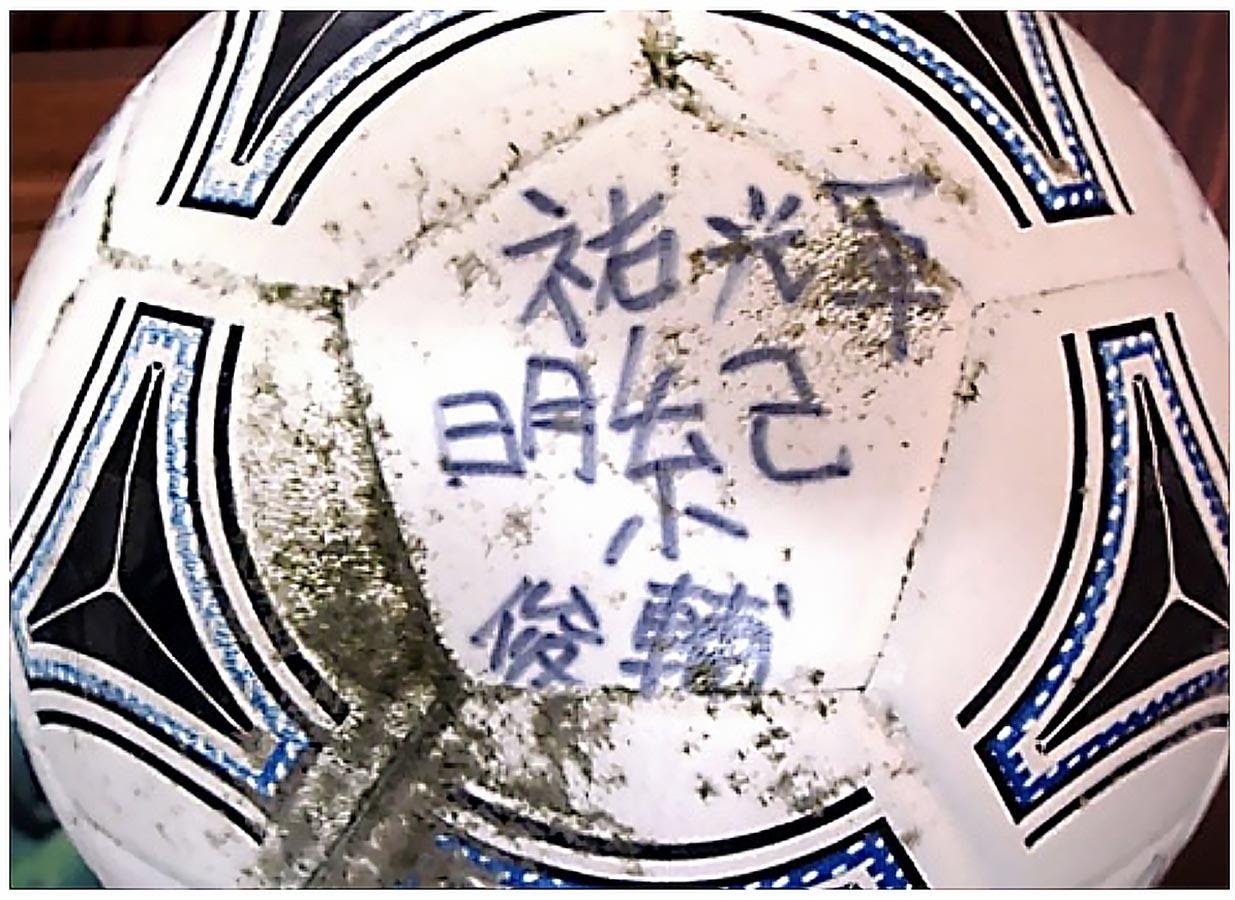
This photo of the soccer ball was taken April 19, 2012.
Harley Davidson Motorcycle
Origin: Yamamoto, Miyagi Prefecture
Found: April 18, 2012 on Graham Island, Haida Gwaii, British Columbia.
On display at the Harley Davidson Museum, Milwaukee
This motorcycle was the prized possession of a young man from Miyagi Prefecture. He kept it in a Styrofoam packing container when he wasn’t using it. The home and the container were pulled into the ocean by the tsunami. In early April 2012, a man hiking on Graham Island saw the container on the beach. Inside, he saw the motorcycle. Three weeks later, he returned to the spot to recover the motorcycle. By this time, waves had destroyed the container. Harley Davidson offered to return the motorcycle, but it was too badly damaged to be of use. They offered to send its owner a new replacement but he refused as so many people had lost so much. The motorcycle is currently on display at the Harley Davidson Museum.
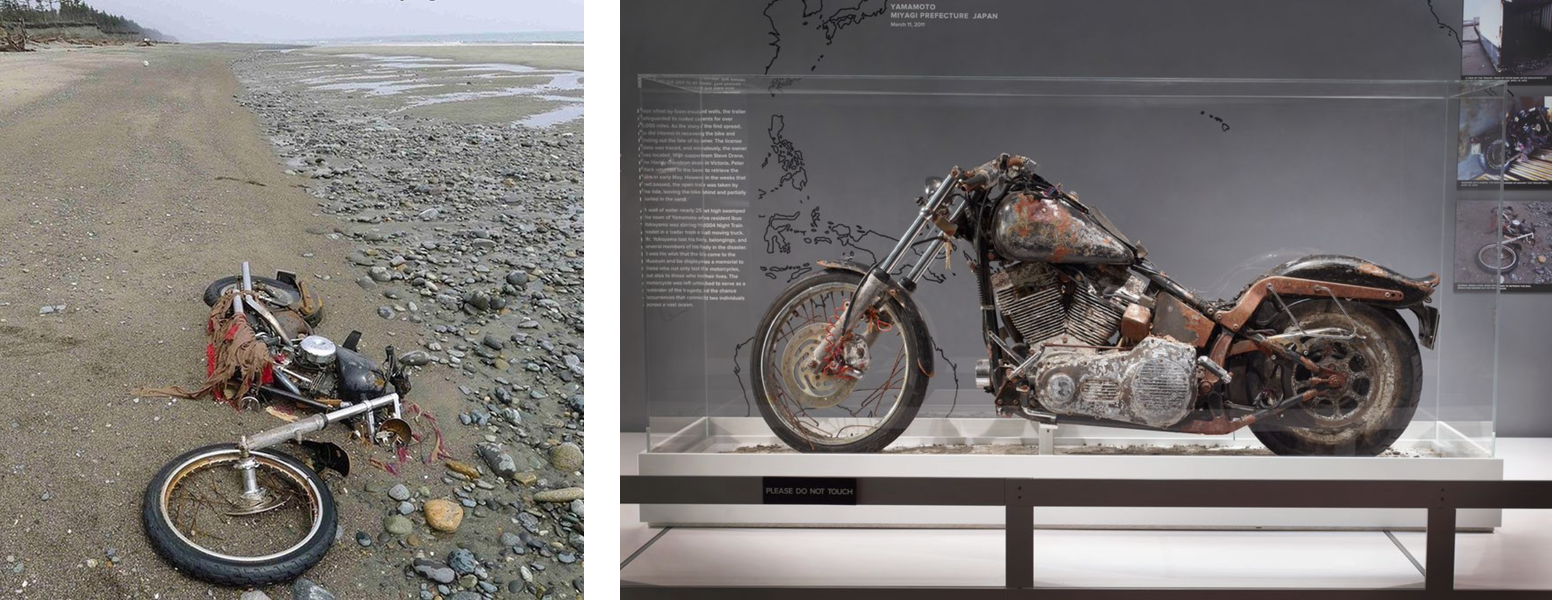
The photo on the left was taken April 18, 2012 when it was found in British Columbia. The photo on the right shows it on display at the Harley Davidson Museum.
Dock
Origin: Misawa, Aomori Prefecture
Found: June 5, 2012, Agate Beach, Central Oregon coast
Demolished
This 66-foot long section of dock had been ripped away from Misawa in the tsunami and preserved much of its original ecosystem. Out of concern that some could invade and damage local ecosystems, the dock was destroyed. Scientists collected nearly 5000 pounds of organic material and catalogued a number of species.

The photo on the left was taken on June 6, 2012 the day after it was found. The photo on the rihgt shows scientists working to collect and catalog organic material.
Kamome
Origin: Rikuzentakata, Iwate Prefecture
Found: Crescent Beach, Crescent City California 4/7/13
Returned to Takata High School (October 2013), began an exchange between students at Takata High School and Del Norte High School (February 2014), Children’s book 2015 (now available in eight languages), Sister City agreement between Rikuzentakata and Crescent City (April and June 2018), featured at the 2021 summer Olympic Games.

Learn more about the Story of Kamome
Take a virtual tour of Del Norte County and plan a visit to see the sights Visit Del Norte County
Explore the region where Kamome landed and read about the lives impacted The Story of Kamome in Crescent City
Village Sign
Origin: Tanohata Village, Iwate Prefecture
Found: Kahuku Beach, Oahu Island, Hawaii 10/13/13
Returned to Tanohata Village (July 2014)
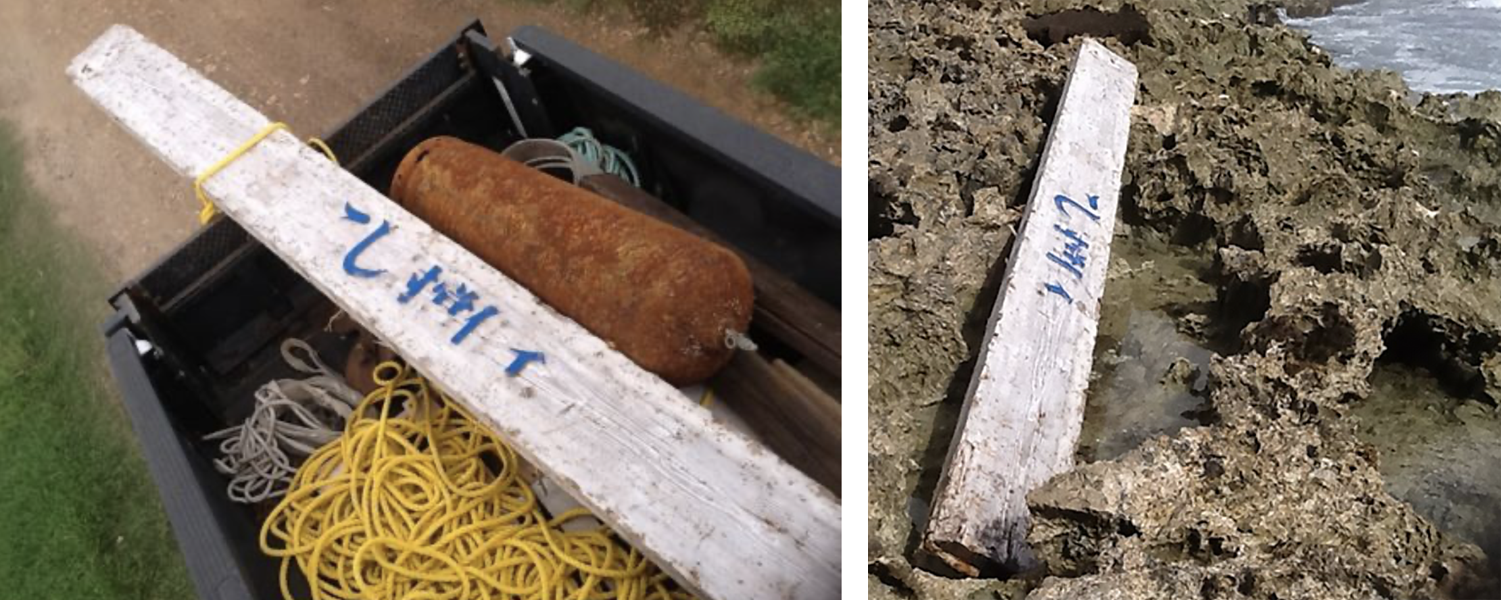
The sign says ““Shimanokoshi village housing”
Panga boat
Origin: Kesennuma, Miyagi Prefecture
Found: #1 12/20/2020 Hachijo, Japan
Fate unkown
In what may be the longest tsunami voyage, this boat was in the ocean for nearly 10 years after the tsunami before it beached on Hachijo Island about 175 miles south of Tokyo. Registration numbers traced to boat to the city of Kesennuma in Miyagi Prefecture where it had belonged to a fishing cooperative before it was lost in the 2011 tsunami. There are no currents that could have carried the boat the nearly 400 miles directly south from Kesennuma to Hachijo. Instead, this boat likely traveled the entire North Pacific Gyre first traveling to the northeast, then east nearly to North America, and then south before the current headed west finally bringing the boat to where it beached.
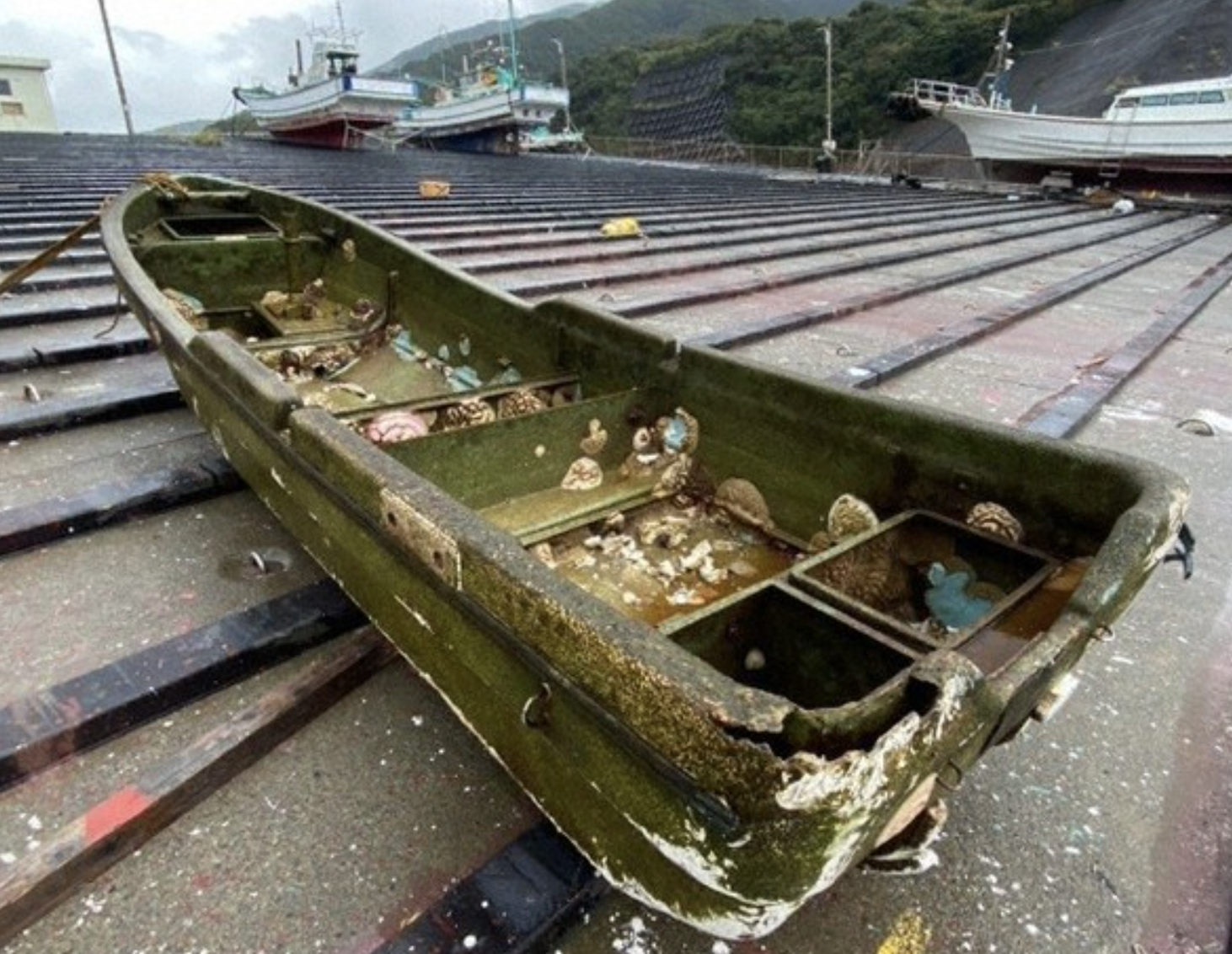
Torii
Origin: Itsukushima Shrine, Okuki Village, Aomori Prefecture
Found: #1 3/22/2013 Oceanside, Oregon; #2 4/9/2013 Florence Oregon
Returned to Okuki Village (September 2015) 
Two carved and painted wooden beams washed up on Oregon beaches in 2013. From the shape, they were determined to be kasagi, part of the curved gate of Torii shrines. From the writing on the second torii, they were traced to Itsukumshima Shrine near Hachinhoe in Aomori Prefecture. The Japanese Gardens in Portland led the effort to discover the origin and return them to Japan.
Was the tsunami debris radioactive?
The Tai Shu Maru was not radioactive. Environmental health staff checked the status of the boat after it was found. This was no surprise because the problems at the Fukushima nuclear power plant didn’t occur until a day after the earthquake and by that time, this boat was already far off the coast. The prevailing winds when radioactive material was released were all to the northwest, blowing particles away from the Pacific Ocean. The particles that were released are water-soluble which means they would quickly be absorbed by the water. No radioactive traces have been found in any of the recovered tsunami debris.
While the boat posed no radioactive hazard, there was concern that it brought a different type of threat. Biologists removed the creatures that had adhered to the boat to make sure that there were no potential invaders that might get a toehold in our ecosystem.
To learn more about tsunami debris and who to contact if you find debris while at the beach, visit What About Tsunami Debris?
Lessons in Resilience
The Tai Shu Maru spent many years as a hard-working fishing boat before the tsunami swept it away. After three years in the Pacific Ocean and being battered by waves on the Humboldt County coast, this boat is still in remarkably good shape, and with only a little work, could still be used today. Its survival is the result of a remarkable design that favors durability. Communities can also be designed for durability in the event of changing fortunes and disasters. The Tai Shu Maru is a lesson for us all.
What can you do to increase your resilience?
There are several steps you can take to increase your resilience in times of natural disasters. Creating an emergency plan and assembling an emergency kit are great places to start. To learn more about how to take action now to increase your resilience, visit our preparedness guide - Living on Shaky Ground.
Thank you
The recovery and display of the Tai Shu Maru was made possible by the collaboration of many individuals and businesses. We extend our thanks to the group of kayakers who found the boat in Dry Lagoon and contacted the National Weather Service, to Steve Tillinghast, Colin Wingfield, and Kerry Sherin for their help with displaying the boat at the Humboldt County Fair, and Troy Nicolini at the National Weather Service Office in Eureka for coordinating the recovery and storage efforts. The shelter was constructed as part of an Eagle Scout Project by Bodhi Merrill of Troop 99 in McKinleyville, California. A special thanks goes to Bodhi and the many partners that helped him accomplish this task including Forbusco Lumber, Hensell’s Materials, Huttig Building Products, The Mill Yard, North Coast Fabricators, Pierson Building Center, Schmidbauer Lumber, Thomas Home Center and Poston’s Engravability. Lastly, we thank our partners in the Redwood Coast Tsunami Work Group for their continued support and efforts to share the story of the Tai Shu Maru with the community, and the California Governor's Office of Emergency Services for their continued funding and support of our outreach efforts on the North Coast.